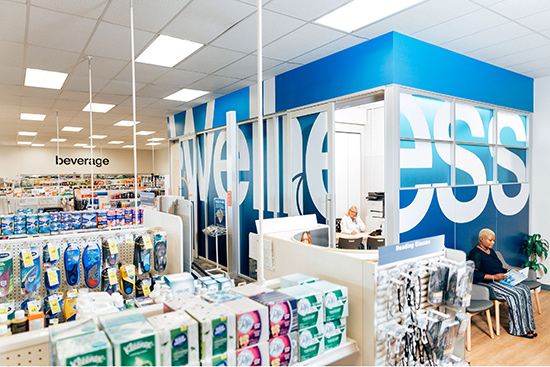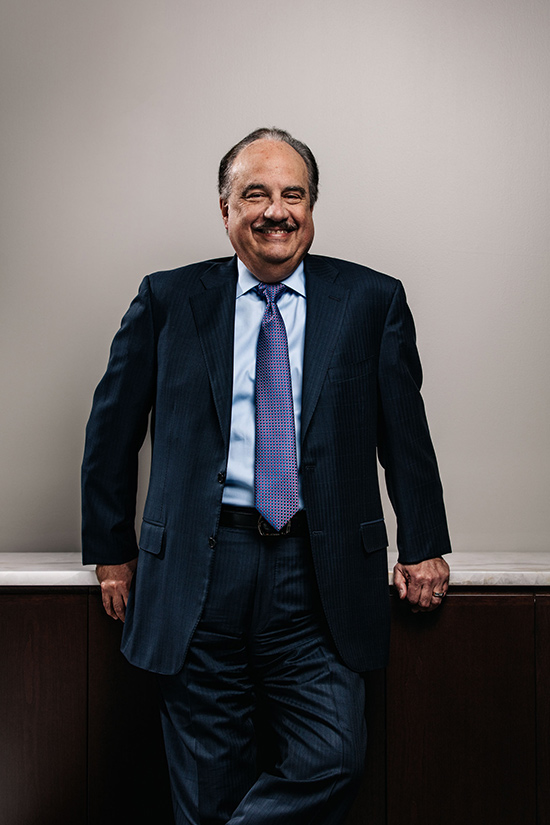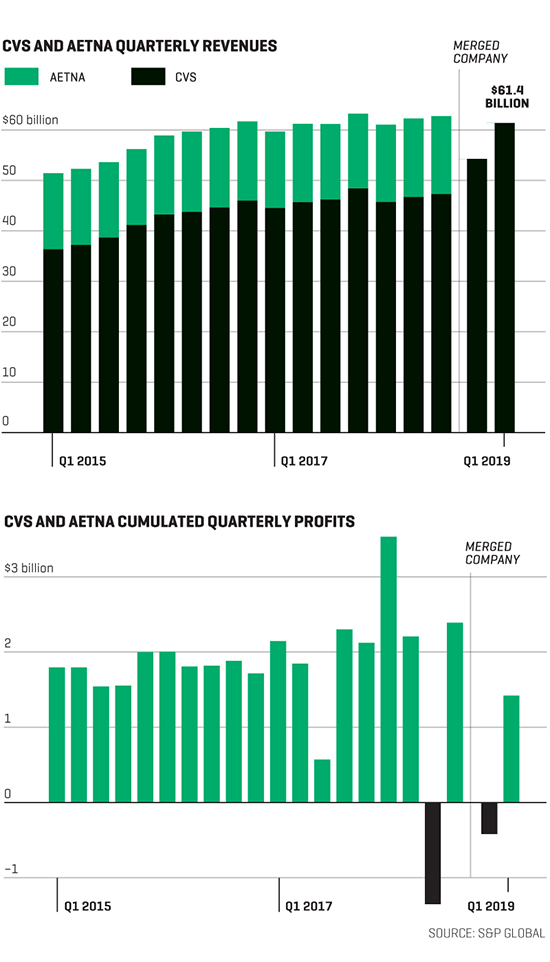這家公司想讓藥店變成醫(yī)生

|
在休斯頓的郊外,,一家看上去很普通也有些陳舊的CVS藥店門口,翻騰的藍色橫幅上寫著“健康中心來了,!”藥房看門杰西·岡薩雷斯站在門口迎接眾人,,用他的話說,“引導(dǎo)”人們前往目標通道或者找醫(yī)生,。睡眠呼吸暫停,?岡薩雷斯會指導(dǎo)打鼾嚴重的人去找呼吸科醫(yī)生,醫(yī)生建議家庭檢測療法,,如果方便的話再推薦購買持續(xù)正壓呼吸機(CPAP)治療,。因為過勞和體重增加而煩惱?他會讓你去看護士,,抽血檢查甲狀腺是否異常,如果確有異常,,護士會給你開激素療法的藥物,,藥房柜臺就能購買。 今年4月的一天早晨,,我跟著岡薩雷斯走過彎曲的木地板小路,,走進重新粉刷后為社區(qū)服務(wù)的新醫(yī)療中心的新前門。這家店位于休斯頓市中心以北的斯普林社區(qū),,周圍居民以工人居多,。店內(nèi)改建了曾經(jīng)賣拖把和賀卡等商品的通道,現(xiàn)在四分之一的面積都用于醫(yī)療保健,。整個左邊的特色產(chǎn)品區(qū)都是為了實現(xiàn)新目標,,從被認為是健康食品的姜黃粉奶昔到各種移動設(shè)備,比如經(jīng)常在倉儲店賣的淋浴椅,。 稍遠處的健康中心跟平常典型的免預(yù)約步入式診所完全不一樣,。這里可以檢測并治療慢性病,,有四間會診室,內(nèi)有醫(yī)療椅和視網(wǎng)膜攝像頭用于糖尿病篩查,。屏幕上顯示著熱門服務(wù)價格:今日糖尿病視網(wǎng)膜病變成像收費100美元,,膽固醇篩查收費89美元。得克薩斯州交通部的員工可以享受全面體檢,。在健康中心隔壁藥房里,,藥劑師亞歷克斯·伊巴拉在私人辦公室為病人提供咨詢,也是新型高接觸實踐,。之前一天,,她向一位需要協(xié)助測量6種糖尿病藥物對血糖影響的老年人解釋了一小時。杰奎琳·海恩斯前往健康中心,,想變得更健康,。護士給她驗血檢測高血壓,醫(yī)生開了處方,,然后去藥房開降壓藥奈必洛爾,。海恩斯稱贊全職營養(yǎng)師幫她從今年1月以來幫助減掉了72磅體重?!艾F(xiàn)在我的體重降到了167.7磅,。”海恩斯說,,她經(jīng)常去CVS周二的“舒緩瑜伽”課,。“我對鱷梨和巧克力上癮了,。營養(yǎng)師幫我安排了健康的飲食,,還教我想吃糖果的時候用低卡可可豆代替?!?!-- cend --> |
Over the entrance of what looks like a regular, aging CVS drugstore outside Houston, a billowing blue banner announces “HealthHUB Come Inside!” Greeting folks at the door is Jesse Gonzalez, the care concierge who, in his words, “navigates” folks to the right aisle or therapist. Sleep apnea problems? Gonzalez dispatches the heavy snorers to the respiratory therapist, who can suggest a home-testing regimen and, if appropriate, recommend a CPAP mask that’s in stock to stop the honking. Fretting over excessive fatigue and weight gain? He’ll guide you to a nurse practitioner who’ll draw blood to test for thyroid disorder and, if that’s the finding, prescribe a hormone therapy you can pick up at the pharmacy counter. On an April morning, I followed Gonzalez down a curving parquet pathway, through this stucco box that’s been repurposed as health care’s new front door for America’s communities. This store in Spring, a working-class neighborhood north of central Houston, has eliminated aisles that once offered the likes of mops and greeting cards so that a full one-fourth of its footprint is now devoted to wellness. The entire left side features products supporting the new mission, from health food—think turmeric powder shakes—to mobile equipment, such as shower chairs, usually found in warehouse stores. The HealthHUB section at the far end goes far beyond what you’d find at a typical walk-in clinic. They offer testing and treatment for chronic conditions, and boast four consultation rooms equipped with exam chairs and retinal cameras for diabetes screening. Video screens display prices for popular services: Today’s rates are $100 for diabetic retinopathy imaging and $89 for a cholesterol screening. Employees from the Texas Department of Transportation get full physicals here. At the pharmacy adjacent to the HealthHUB, pharmacist Alex Ybarra counsels patients in a private office as part of the new high-touch approach; the previous day, she spent an hour advising a senior who needed help measuring the effect of his six diabetes medications on his blood sugar. The HealthHUB is Jacqueline Haynes’s destination for wellness. She was given a blood test for hypertension by a nurse practitioner, who wrote a prescription for beta-blocker Bystolic that Haynes filled at the pharmacy, steps away. She credits the full-time dietitian with helping her shed 72 pounds since January. “That brings my weight to 167.7,” says Haynes, who frequents a CVS “gentle yoga” class on Tuesdays. “I was addicted to avocados and chocolate. He got me eating healthy by doing things like substituting low-cal cacao nibs when I craved candy bars.” |

|
健康中心的概念標志著醫(yī)療改革的飛躍,,即通過緊急醫(yī)療網(wǎng)店,、門診手術(shù)中心和藥店的快速護理中心,將原本要去大型醫(yī)院,,找極其難約的醫(yī)生看病需求疏導(dǎo)至社區(qū),。CVS Health稱此舉立足本地,又可以提供全面的服務(wù),。 為了支持該策略,,過去十年CVS一直在建立步入式診所,提供疫苗接種和流感疫苗注射等簡單治療,,也剛剛成為第一家與保險公司合并的大型藥品零售商,。去年11月底,,CVS斥巨資700億美元收購了美國第三大保險公司安泰,由此成為全世界最大的醫(yī)療上市公司,,然而注意到這點的人還不多,。目前《財富》美國500強排行榜上CVS名列第8位,明年排名可能會跳升幾位,。如果算上安泰全年收入,,而不是像去年一樣僅加上CVS收購后安泰一個月的收入,合并后公司銷售額將達到2560億美元,,躍升至僅次于沃爾瑪,、埃克森美孚和蘋果之后的第4位,。 CVS收購安泰是2018年最大一起并購案,,也超越了醫(yī)療領(lǐng)域里程碑,即信諾保險以544億美元收購快捷藥方公司,。但該筆大交易與通常的石油,、移動通信或媒體巨頭合并完全不同,因為石油之類行業(yè)為客戶提供類似的產(chǎn)品和服務(wù),。CVS與安泰的合并則聯(lián)合了醫(yī)療領(lǐng)域里兩個截然不同且迄今為止獨立的業(yè)務(wù),。一家公司精通IT業(yè)務(wù),部署機器學(xué)習(xí)和人工智能預(yù)測大量客戶下一步舉措,,另一家則是老牌實體店,,通過展示、促銷和優(yōu)惠券吸引人們購買藥品到化妝品之類的營銷高手,。在醫(yī)療行業(yè)的大型并購案中,,此次相當(dāng)于下注大數(shù)據(jù)和鄰家藥店的聯(lián)姻可以令美國更加健康,無疑是最大膽也最危險之舉,。 |
The HealthHUB concept marks a forward leap in what’s already a revolution in health care: bringing treatment once dominated by giant hospitals and overbooked doctors’ offices to America’s neighborhoods via urgent care outlets, outpatient surgery centers, and quick care outlets in pharmacies. CVS Health claims to be both the most local and the most comprehensive. To bolster that strategy, CVS—which has been building its own walk-in clinics for over a decade, providing simple treatments like vaccinations and flu shots—just became the first major drug retailer to combine with an insurer. In late November, CVS bought Aetna, America’s third-largest insurance carrier, in a $70 billion megadeal that made the new CVS the world’s largest publicly traded health care company, a distinction that, until now, had gone largely unnoticed. CVS ranks eighth on the Fortune 500 list, but look for it to make a big jump on next year’s roster. Had Aetna’s revenues been included for the entire year, instead of just the one month it was owned by CVS, the combined company would have posted sales of $256 billion and catapulted to fourth place behind Walmart, Exxon Mobil, and Apple. The CVS purchase of Aetna was the largest merger of 2018, edging another health care milestone, Cigna’s $54.4 billion acquisition of Express Scripts. But this big deal is totally unlike the usual combinations of oil, mobile communications, or media giants that provide their customers with similar products and services. The CVS-Aetna union brings together two distinct, and heretofore separate, fields of health care: an insurer that’s a master of IT, deploying machine learning and A.I. to predict the next step for a vast population of enrollees; and an old-line, brick-and-mortar merchant, a marketing machine that uses displays, promotions, and coupons to get people to buy everything from drugs to cosmetics. Of all the big health care mergers, this bet that marrying big data and neighborhood drugstores will create a healthier America is the most daring—and the riskiest. |

|
總體規(guī)劃是結(jié)合安泰公司的索賠數(shù)據(jù)和分析,確定在2200萬會員里哪些人有患糖尿病或心臟病的風(fēng)險,,然后CVS發(fā)揮能力,,指導(dǎo)相關(guān)會員前往藥房或健康中心做體檢或接受治療。這種方案的目標是限制再入院率并敦促患者遵守藥物治療方案,,從而節(jié)省巨額成本,。第二階段包括召集CVS最大的客戶,主要是其他保險公司,,采取全新模式后確保CVS獲得部分收益,,因為CVS通過店內(nèi)診所提供咨詢和篩查服務(wù)實現(xiàn)巨大節(jié)省,,病人不必再去手術(shù)室和急診室。 然而投資者認為,,CVS才應(yīng)該好好體檢一下,。該公司的股價曾經(jīng)長期保持優(yōu)異,但在過去三年里出現(xiàn)逆轉(zhuǎn),,股價急劇下滑,。截至2015年的十年里,CVS實現(xiàn)年度總回報率15.3%,,是標準普爾500指數(shù)回報率的兩倍,。2016年春跌勢初現(xiàn),2017年10月宣布收購安泰后加速下滑,。CVS股價走低以來已下跌28%,,從76美元跌至56美元。 問題主要有兩個層面,。首先,,華爾街認為CVS收購安泰時出價過高。合并傳言傳播時,,兩家公司市值加起來還有1280億美元,,如今只有720億美元,意味著多達560億美元(占總市值的44%)已經(jīng)消失,。問題在于,,CVS為安泰支付了32%的溢價,而且過程中其財務(wù)報表上增加了780億美元的資本,。 其次,,CVS在收購時,自身的核心業(yè)務(wù)出現(xiàn)惡化,。因此到目前為止,,其收購安泰增加的額外資本僅獲得了微薄回報。判斷業(yè)績下降程度有個很好的指標便是經(jīng)濟增加值,,也是研究公司ISS EVA使用的工具,,ISS EVA隸屬于公司治理顧問——機構(gòu)股東服務(wù)(ISS)。EVA主要判斷公司有沒有在賺取“資本成本”,,也是回報投資者的最低要求,。合并前一年,CVS的稅后凈營業(yè)利潤(NOPAT)為77億美元,,安泰保險為33億美元,,總計110億美元,兩個數(shù)字都輕松超過了5.4%的資本成本,盡管當(dāng)時CVS的業(yè)績已經(jīng)在下滑,。機構(gòu)股東服務(wù)高級顧問貝內(nèi)特·斯圖爾特認為,,合并后的CVS要多賺11億美元,或者說121億美元才能補上收購安泰支付的巨額溢價,。但合并后的公司利潤比起2018年并沒有增加,,反而在減少。至于2019年,,由于市場上對CVS業(yè)績預(yù)期普遍負面,,分析師預(yù)測今年的稅后營業(yè)收入僅為1050億美元,比2018年低5億美元,,比收購安泰后實現(xiàn)足夠回報所需的金額少了16億美元,。 聽起來很糟糕。但請注意,,投資者已經(jīng)大幅減持了CVS股票,。所以現(xiàn)在重要的是,與跌跌不休的股價相比未來收益會怎樣,?!邦A(yù)期實在太低,如果CVS能夠?qū)崿F(xiàn)降低到105億美元的預(yù)期并有所改善,,模型顯示其股價低估了多達80%,。”斯圖爾特表示,。將CVS估值調(diào)整為720億美元后,,投資者預(yù)測最終其業(yè)績也只是一般水平。 但CVS團隊的野心不止于此,。 |
Today the master plan is to combine Aetna’s claims data and analytics that identify which of its 22 million members are at risk for, say, developing diabetes or cardiac disease, with CVS’s capacity to guide them to testing and treatment before the disease progresses, at the pharmacies and HealthHUBs. That formula is targeted to generate big savings by curbing readmissions to hospitals and getting patients to adhere to their drug regimens. Phase 2 consists of recruiting CVS’s biggest customers, mostly other insurers, to adopt a fresh model that gives CVS a share of the potentially giant savings to come from counseling and screenings at their corner clinics that keep patients out of operating and emergency rooms. Investors, however, think it’s CVS that could use a checkup. Its stock’s steep slide over the past three years is a reversal from a long history of outperformance. Over the decade through 2015, CVS delivered total annual returns of 15.3%, double the trend for the S&P 500. The cratering started in the spring of 2016, then accelerated after reports of an Aetna deal surfaced in October of 2017. Since CVS’s decline began, its stock price has dropped 28%, from $76 to $56. The problem is twofold. First, Wall Street is judging that CVS way overpaid for the insurer. When rumors of a merger spread, the companies’ combined market caps stood at $128 billion. Today that figure is $72 billion, meaning that a staggering $56?billion, or 44% of the total, has vanished. The rub is that CVS paid a 32% premium for Aetna and, in the process, loaded an additional $78 billion in capital on its books. Second, CVS did this deal just when its own core businesses were deteriorating. Hence, it’s so far generating weak returns on all the extra capital added by purchasing Aetna. A good measure of how far the performance has declined is Economic Value Added, a tool deployed by research firm ISS EVA, a branch of governance adviser Institutional Shareholder Services. EVA measures whether companies are earning their “cost of capital,” the minimum requirement for rewarding investors. In the year prior to the merger, CVS had net operating profit after tax (NOPAT) of $7.7 billion, and Aetna achieved $3.3 billion, for a total of $11?billion, numbers that both easily beat their 5.4% cost of capital, though the CVS figure was already sliding. Bennett Stewart, a senior adviser to ISS, reckons that the new CVS would have needed to earn $1.1 billion more, or $12.1 billion, just to break even on the big premium paid for Aetna. The rub is that the combined enterprise is making not more, but less now than in 2018 when the deal closed. For 2019, based on CVS’s generally negative guidance, analysts predict that it will earn just $10.5?billion in after-tax operating income for this year, $500 million below 2018, and $1.6 billion less than the amount needed to achieve an adequate return on the Aetna deal. Sounds bad. But keep in mind that investors have radically marked down CVS stock. So what matters now is how its future earnings compare with its beaten-down price. “The expectations are so low that if CVS meets that reduced $10.5 billion forecast and improves from there, our models show that its stock is undervalued by as much as 80%,” says Stewart. By valuing CVS at a lowly $72 billion, investors are forecasting that it merely achieves mediocrity. But the team at CVS had much bigger aspirations in mind. |
****
|
不完全為了利潤的合并 在斥資700億美元與安泰合并后,,CVS躍升為全球最大的醫(yī)療公司,預(yù)計2019年收入將達到2500億美元,。但目前為止還未見成效,。2019年第一季度,CVS公布的利潤數(shù)字比一年前兩家公司分別賺取的利潤低三分之一,。整合計劃目標是節(jié)省7.5億美元,,將有助于提高盈利能力。 |
A merger that has not equaled profits The $70 billion merger with Aetna made CVS the world’s biggest health care company, with projected revenues of $250 billion in 2019. But so far it hasn’t paid off. In the first quarter of 2019, the new CVS posted profits one-third lower than the amount the two companies had earned separately a year earlier. An integration plan targeting $750 million in savings should help lift profitability. |
 ****
****
|
在生活節(jié)奏緩慢的羅德島文索基特,,CVS類似校園的總部里,,首席執(zhí)行官拉里·梅洛給出了自己的理由。他認為,,收購安泰支付的巨額價格是值得的,因為結(jié)合之后將為醫(yī)療保健創(chuàng)立全新模式,?!拔覀冋J為并沒有花冤枉錢,。”梅洛表示,。他氣質(zhì)純樸,,留著胡子,之前是藥劑師,,最出名的是2014年禁止煙草制品進店銷售,。“這是改變醫(yī)療體驗的絕好機會,,把社區(qū)當(dāng)成治療中心,。”確實,,今年5月1日的一次電話會議上,,CVS宣布實際效果好于預(yù)期,梅洛談到了將健康中心當(dāng)成新的CVS業(yè)務(wù)核心的計劃,。投資者很贊同,。隨后股價大漲5.4%,市值增加了近40億美元,。 CVS的便利店式醫(yī)療要想成功,,主要靠兩大支柱。首先是分布廣泛,。目前CVS旗下有9900家藥店,,與美國最大的連鎖藥店沃爾格林基本持平。80%的美國家庭要找CVS藥房只需步行或駕車10英里以內(nèi),。目前CVS已經(jīng)在運營1100個“一分鐘診所”,,提供流感疫苗和帶狀皰疹疫苗等基本服務(wù),是沃爾格林店里的步入式診所數(shù)量的兩倍多,。沃爾瑪是第三大藥房,,只在三個州有少數(shù)幾家店內(nèi)診所。5月初,,CVS稱計劃將休斯頓的三家健康中心增加到20家,,城區(qū)每七家店里便有一處,并承諾6月將宣布更大規(guī)模的推廣計劃,。如果CVS將現(xiàn)有的一分鐘診所擴建為健康中心,,并且在全國范圍保持一分鐘診所覆蓋比例,分析師認為可能性很高,。那么根據(jù)《財富》雜志計算,,可能美國四分之三的家庭附近10英里以內(nèi)就能有一家健康中心。 第二大支柱是大型保險公司的影響力。新的CVS加安泰是結(jié)合制藥行業(yè)三個主要領(lǐng)域的巨頭:零售店,、保險和藥品福利管理(或簡稱PBM,,主要負責(zé)管理處方藥計劃)。美國最大的保險公司聯(lián)合健康集團經(jīng)營著一家藥品福利管理,、醫(yī)生診所,,還有大約200家步入式診所,但沒有零售店,。沃爾格林與藥品福利管理合作但旗下沒有保險公司,,排名第五的保險公司信諾最近收購了最大的藥品福利管理快捷藥房,運營健康維護組織但沒有社區(qū)診所,。合并后的CVS關(guān)注重點是利潤在哪,,即慢性疾病管理。成年人里50%到60%的人患有五大疾病中的一種或多種:糖尿病,、高血壓,、心臟病、抑郁癥和哮喘,。相關(guān)疾病占美國每年3.5萬億美元醫(yī)療支出的80%,。 新模式的核心在于將安泰客戶的每個健康細節(jié)(包括住院、實驗室檢測和醫(yī)生診斷)數(shù)據(jù)交給藥劑師和健康專家,,這些專家會經(jīng)常與客戶面對面交流,,比客戶生活中的醫(yī)療人員更頻繁。安泰利用人工智能分析后,,也會告訴健康中心的一線人員,,從遺傳學(xué)和病史來看哪些人可能罹患疾病?!耙话愠赡耆嗣磕昕瘁t(yī)生1.6次,。”梅洛說,?!叭藗兡锰幏剿幍拇螖?shù)比看醫(yī)生多多了?!?!-- cend --> |
In his office at CVS’s campus-like headquarters in the sleepy town of Woonsocket, R.I., CEO Larry Merlo is making his case: namely, that the big price for Aetna was deserved because the combination will establish a new paradigm for health care. “We don’t look at this as overpaying,” says Merlo, a folksy, mustachioed former pharmacist who famously banished tobacco products from his stores in 2014. “It’s a tremendous opportunity to transform the health care experience, to put the community at the center of care.” Indeed, on a May?1 conference call in which CVS announced better-than-expected results, Merlo discussed plans to make HealthHUBs the cornerstone of the new CVS. Investors liked what they heard. Shares surged 5.4%, adding almost $4 billion in value. CVS is relying on two pillars to make its convenience-store approach to health care a success. The first is its giant footprint. It operates 9,900 drugstores, standing in a virtual tie with Walgreens as the nation’s largest drugstore owner. Eighty percent of America’s families need to walk or drive 10 miles or less to reach a CVS. Today, it’s already running 1,100 MinuteClinics, which provide such basics as flu shots and shingles vaccinations, more than twice the number of walk-in outlets in Walgreens stores. Walmart, the No.?3 pharmacy owner, has just a smattering of in-store clinics in three states. In early May, CVS unveiled plans to grow its three Houston HealthHUBs to 20, or one for every seven stores in the metro area, and pledged to announce a bigger rollout plan in June. If CVS applies the same “hub-and-spoke” ratio nationwide that it now uses for the MinuteClinics by expanding the existing MinuteClinics into HealthHUBs—and analysts think that’s likely—a HealthHUB, by Fortune’s calculations, could be within 10 miles of three-quarters of America’s homes. The second mainstay is the clout of a giant insurer. The new CVS-Aetna is a colossus that combines the pharmacy industry’s three major areas: retail stores, insurance, and a pharmacy benefit manager (or PBM, which manages prescription drug plans). America’s largest insurer, UnitedHealth Group, operates a PBM, physicians’ practices, and about 200 walk-in clinics, but no retail stores. Walgreens partners with a PBM but doesn’t own an insurer, and fifth-ranking insurer Cigna recently acquired the largest PBM—Express Scripts—and runs HMOs but doesn’t operate neighborhood clinics. The new CVS is focusing on where the money is: managing chronic conditions. Between 50% and 60% of all adults suffer from one or more of the top five: diabetes, hypertension, cardiac disease, depression, and asthma. Those conditions account for 80% of America’s $3.5 trillion in annual health care spending. The new model’s Rx is to hand Aetna’s data on every detail of its members’ health—including hospitalizations, lab tests, and doctors’ diagnoses—to the pharmacists and wellness specialists who encounter those folks in person far more often than anyone else in their health care orbit. Aetna’s analytics, deploying artificial intelligence, also tell the HealthHUBs’ front line who, from genetics and medical history, is more likely to contract the conditions. “The average adult visits the doctor 1.6 times a year,” says Merlo. “People pick up prescriptions a lot more often than they see a physician.” |
|
盡管如此,,CVS必須謹慎行事,避免跨越消費者隱私的法律界限,,或讓消費者感覺公司太了解自己,。很多州和地方法律規(guī)定,只有直接參與提供或評估患者治療的員工才能查看病史,,也就是安泰的營銷團隊無法在CVS查看處方歷史,。法規(guī)還限制了哪些人能開處方和做檢測,,限制了艾滋病和精神健康患者的數(shù)據(jù)共享。隱私權(quán)倡導(dǎo)者已經(jīng)開始關(guān)注保險和零售歷史的結(jié)合,?!斑@種模式就是誘導(dǎo)患者購買更加昂貴的藥品從而增收,因為CVS了解患者的所有信息,。”狄波拉·皮爾博士表示,。他是一位精神病學(xué)家,,也是游說團體患者隱私權(quán)的主席。 很明顯,,如果在藥店里加入許多初級保健功能,,可以提高效率。但梅洛還有一個更宏大的想法,,他希望保險公司和保健組織向CVS付費,,讓人們保持健康。 |
Still, CVS must proceed cautiously to avoid either crossing legal boundaries governing consumer privacy or provoking customers’ perception that it knows too much about them. A thicket of state and local laws mandate that only employees directly involved in providing or assessing patient care can view medical histories—meaning marketing teams at Aetna can’t review prescription histories from CVS. Regulations also limit who is able to prescribe and perform tests, and restrict data-sharing for HIV and mental health patients. Privacy advocates are already raising concerns about mixing insurance and retail histories. “It’s a way to leverage more revenue from patients by steering them to their own more expensive pharmacies because CVS will know everything about them,” says Dr. Deborah Peel, a psychiatrist who is president of the advocacy group Patient Privacy Rights. It’s clear there are efficiencies to be gained from bringing many of those primary-care functions to the local drugstore. But Merlo has another, bigger idea: He wants insurers and HMOs to pay CVS to keep people healthy. |
****
|
“目前在藥房業(yè)務(wù)中,,并沒有節(jié)約成本的分配機制,。”CVS內(nèi)部掌管830億美元零售藥房業(yè)務(wù)的主管凱文·霍利肯表示,。CVS如何采取對策改變,?“我們將在安泰內(nèi)部開展工作,先證明能做,,再推廣到其他大型保險公司,。”霍利肯指出,,每年700萬例再入院病例中有四分之一可以預(yù)防,,大多數(shù)都是因為患者不服用慢性病藥物或服藥不當(dāng)。通過健康中心提供的咨詢服務(wù),,平均花費14000美元的復(fù)診費用可能會大幅削減,。“如果我們的服務(wù)能讓瓊斯女士不用回醫(yī)院奔波就解決病痛,,為保險公司節(jié)省1萬美元,,那么我希望得到節(jié)省費用里的X%?!?霍利肯說,。 分成非常關(guān)鍵,因為CVS有塊重要業(yè)務(wù)正在下降:費用報銷,?!鞍从媱澸厔輵?yīng)該是,,‘去年付給你10美元,明年會付給你9美元,?!被衾险f。結(jié)果是,,利潤率不斷承受壓力,。反過來,這也是各種因素共同作用,。新的仿制藥報銷金額往往是品牌藥品的三倍,。但近幾年仿制藥流通速度有所放緩,部分原因是仿制藥在處方總量中的占比已經(jīng)飆升至90%左右,。藥店也面臨向“特殊”藥物轉(zhuǎn)移的痛苦,,每年花費10000美元以上,主要治療類風(fēng)濕性關(guān)節(jié)炎和丙型肝炎等復(fù)雜疾病,,通常在單獨的藥房或郵遞分發(fā),。 各地的藥品福利管理也發(fā)生了重大變化。而且由于2007年收購Caremark并在集團下保持快速增長后,,CVS變成了主要參與者,。2012年以來,Caremark的營業(yè)利潤增長了75%,,達到47億美元,,咨詢公司Grand View Research預(yù)計,到2026年藥品福利管理行業(yè)規(guī)模將翻番,,收入達到7500億美元,。 不過Caremark和藥品福利管理行業(yè)面臨著嚴重威脅,可能影響預(yù)期達成,。擬議中的法規(guī)將限制最擅長的模式,,壓低藥品價格。Caremark為保險公司和健康維護組織管理處方藥計劃,,為藥店分發(fā)的藥品付費,。因此,實際上Caremark一直引導(dǎo)大部分保險公司用戶前往接受最低報銷額度的連鎖店,,導(dǎo)致CVS藥房和沃爾格林之類的公司都很痛苦,。 Caremark在為贊助商提供大幅折扣方面的效率又非常高,其贊助商包括安泰保險和數(shù)十家其他大型保險公司以及健康維護組織,,給CVS的零售利潤造成壓力,。以下是具體流程,Caremark編制“處方集”,,也就是基于成本的推薦藥物列表,,而且健康計劃里都覆蓋,。處方集指導(dǎo)醫(yī)生、護士和醫(yī)院開處方,,也建議患者選擇同類藥中療效相同但價格最低的品類,。舉個例子,只要能選擇,,CVS總是將新出仿制藥換成品牌藥,。藥品福利管理則會比較同類藥物,最終選擇實價最低的種類,。 過去三年里,,CVS已經(jīng)獲得了大約1400億美元折扣,并通過爭取折扣將品牌藥品的實價上漲保持個位數(shù)較低水平,。去年,CVS用禮來新獲批的生物仿制藥Basaglar代替了賽諾菲出品特別昂貴的處方藥來得時,。來得時的30天處方藥花費是340美元,,而Basaglar的花費是235美元。在27000名受影響的患者中,,四分之三的人選擇了Basaglar和其他低成本的替代品,,為Caremark的計劃節(jié)省了大筆資金。 情況很復(fù)雜,,但在衛(wèi)生和公眾服務(wù)部提出新規(guī)則并應(yīng)用于醫(yī)療保險和醫(yī)療藥品計劃里之后,,對藥品福利管理形成了威脅。在目前的制度下,,Caremark和同行獲得的折扣幾乎全部歸保險公司所有,,保險公司則用這些錢降低保費(患者的共同支付和免賠額仍然基于官方“清單”價格)。大制藥公司支持的擬議規(guī)定將把大部分折扣從保險公司轉(zhuǎn)移出去,,轉(zhuǎn)而降低患者在藥房的共同支付金額,。整個生態(tài)都要隨之變化?!叭缃翊蠊P用于降低保費的資金將用于降低共同支付和免賠額,。”美國企業(yè)研究所的經(jīng)濟學(xué)家約瑟夫·安托斯表示,。 現(xiàn)在,,競爭計劃通過提供最低保費吸引老年人。如果提議或通過,,藥品福利管理節(jié)省下來從而幫保險公司降低保費的資金也會減少,。正如安托斯指出,這才是老年人最關(guān)心的事,。如此一來,,以低保費獲取大批新客戶的能力將削弱,,藥品福利管理對該計劃的價值降低,費用也可能下調(diào),?!按笾扑幑酒毡橹С帜稠椞嶙h時,一定要加倍注意,?!泵仿逭f。確實,,相關(guān)規(guī)定可能會削弱CVS最大的盈利來源,。 那么,有什么替代方案呢,? |
In the pharmacy business, no mechanism now exists for sharing savings,” says Kevin Hourican, chief of the $83?billion retail pharmacy business at CVS. The company’s game plan to change that? “We’ll do it internally with Aetna to prove we can do it ourselves, then bring it to the other big insurers.” Hourican notes that a quarter of the 7 million hospital readmissions each year are preventable, and that most are caused by patients who either don’t take their chronic-care medications or take them incorrectly. The return visits, costing $14,000 on average, could be sharply reduced through the type of counseling offered at the HealthHUBs. “If I can save an insurer $10,000 by preventing Ms. Jones from going back to the hospital, I want to share x percent of the savings,” says Hourican. That’s key, because an important part of CVS’s business is in decline: reimbursements. “The trend from the plans is, ‘Last year we paid you $10—next year we’ll pay you $9,’?” says Hourican. Result: unremitting pressures on margins. That, in turn, is due to a convergence of factors. New generic drugs are typically reimbursed at three times the rate of branded drugs. But the flow of generics has slowed in recent years, in part because their share of total prescriptions has already soared to around 90%. Drugstores are also suffering from a shift to “specialty” drugs that cost $10,000-plus a year, treat such complex diseases as rheumatoid arthritis and hepatitis C, and are typically dispensed at separate pharmacies or by mail. But there are also significant changes happening in the PBM, or pharmacy benefit manager, world. And it’s a world where CVS is a major player, thanks to its 2007 acquisition of Caremark, which has grown fast under CVS’s ownership. Since 2012, Caremark’s operating profits jumped by 75% to $4.7 billion, and consulting firm Grand View Research predicts that the PBM industry will double in size to $750 billion in revenues by 2026. But Caremark and the PBM industry face a major threat that could undermine that forecast: proposed regulations that would limit what they do best, hold down drug prices. Caremark manages prescription drug plans for insurers and HMOs that pay for the drugs dispensed by pharmacies. So, in effect, Caremark tortures its own CVS drugstores, as well as the likes of Walgreens, by directing the lion’s share of their insurers’ members to the chains that accept the lowest reimbursements. Caremark has been extremely effective in driving deep discounts for its sponsors, a group that encompasses the premerger Aetna and dozens of other big insurers and HMOs, thereby putting pressure on CVS’s retail margins. Here’s how it works: Caremark establishes “formularies,” or lists of preferred medications based on cost, that your health plan agrees to cover. The formularies guide physicians, nurses, and hospitals to prescribe—and patients to request—the least expensive drugs in any category shown to be medically equivalent. CVS, for example, always substitutes new generics identical to branded names when they become available. The PBMs pit those me-too drugs against one another, choosing the one that offers the lowest net price. In the past three years, CVS has secured around $140 billion in rebates and held net branded drug price increases in the low single digits by wresting these bargains. Last year it replaced Sanofi’s super-expensive Lantus on its formulary with a newly approved biosimilar, ?Basaglar from Eli Lilly. Lantus was priced at $340 for a 30-day prescription, versus $235 for Basaglar. Three-quarters of the 27,000 affected patients switched to Basaglar and other low-cost alternatives, producing big savings for Caremark’s plans. It’s complicated, but the new rules that threaten the PBMs, advanced by the Department of Health and Human Services, apply to Medicare and Medicaid drug plans. Under the current system, the discounts won by Caremark and its peers go almost entirely back to the insurance companies, which use the money to reduce premiums (patients’ co-pays and deductibles are still based on official “l(fā)ist” prices). The proposed regulations, backed by big drugmakers, would shift a large share of the discounts away from insurers and instead lower co-pays at the pharmacy counter. That would change the dynamic of this whole ecosystem. “A lot of the money that now goes to lowering premiums would go to [lowering] co-pays and deductibles,” says Joseph Antos, an economist at the American Enterprise Institute. Today, competing plans attract seniors by offering the lowest premiums. If the proposed regulation goes through, the insurers would have less of those PBM-generated savings to put toward lowering insurance premiums, which, as Antos points out, is what seniors care most about. That would weaken the ability of the plans to gain hordes of new customers with low premiums, hence the value of the PBMs to the plans would diminish, and their fees could shift downward. “When Big Pharma universally backs a proposal, your antenna goes up,” says Merlo. Indeed, the regulations could undermine what’s been CVS’s best profit engine. So, what could take its place? |
****
|
“每天有1萬人滿65歲,。”56歲的安泰公司總裁凱倫·林奇說,?!靶驴蛻艉茈y找到更好的選擇?!痹贑VS收購安泰時,,也將林奇納入麾下。她負責(zé)的醫(yī)保優(yōu)惠專營(可替代醫(yī)保的私人管理計劃)是合并后公司的業(yè)務(wù)增長引擎,。 林奇在安泰時,,優(yōu)惠專營業(yè)務(wù)成員從2013年的96.8萬增加到如今的220萬,她現(xiàn)在除了繼續(xù)負責(zé)該業(yè)務(wù),,也負責(zé)CVS旗下SilverScript部門的聯(lián)邦醫(yī)療保險處方藥物計劃(向老年人提供的私人管理補充處方藥計劃),。安泰是率先提供前往醫(yī)院和診所交通服務(wù)的公司之一,也是第一批向老年人提供緊急護理服務(wù)不額外收費的公司,。林奇母親自殺時她才12歲,,在她的領(lǐng)導(dǎo)下,安泰提供了最慷慨的行為健康計劃之一,。 現(xiàn)在優(yōu)惠計劃已經(jīng)發(fā)展成為規(guī)模超過200億美元的業(yè)務(wù),,占安泰銷售額的三分之一,不過CVS還有很大發(fā)展空間,。其醫(yī)保優(yōu)惠專營規(guī)模仍然遠小于兩家行業(yè)領(lǐng)導(dǎo)者UnitedHealth和Humana,。增速確實很快。第一季度新成員數(shù)激增了14萬人,,增加了27%,,也是大型醫(yī)保優(yōu)惠計劃里增速最快的。 對CVS來說,,從“讓人們恢復(fù)健康”的藥店連鎖到打造前所未見的組合,,可以說是巨大的戰(zhàn)略延伸,,可能會改變醫(yī)療保健的未來。CVS與安泰的交易在未知領(lǐng)域取得突破,,結(jié)果很難預(yù)測,。可以比作開拓性的治療方法,,可能拯救數(shù)百萬人的生命,,但尚未經(jīng)過檢測。為了進一步推動,,CVS需要通曉兩方面業(yè)務(wù)的領(lǐng)導(dǎo)者,,也需要能夠打通兩塊業(yè)務(wù)的新思路。 林奇就是個好例子,。之前董事會選擇她接替退休的安泰首席執(zhí)行官馬克·貝托里尼,,也是接替63歲梅洛的熱門人選。為了利用好零售商與保險公司的聯(lián)姻,,她在應(yīng)用CVS稱之為“盒內(nèi)恢復(fù)”的概念,。“出現(xiàn)問題最好的時機是病人第一次出院時,。”她表示,。比如某個病人剛做過膝關(guān)節(jié)手術(shù),。根據(jù)“盒內(nèi)恢復(fù)”概念,安泰保險的護理經(jīng)理會通知健康中心的護理看門人或藥劑師,,安排從醫(yī)院回家的交通,,送給病人一個大包裹,其中包括新處方,、膝蓋踏板車,、沐浴椅和頭幾天里的健康膳食?!澳壳暗姆嵌ㄆ谧o理系統(tǒng)下,,人們只在出現(xiàn)問題時才去治病,今后取而代之的是在生活購物的地方獲得服務(wù),。我們是醫(yī)療的新大門,。”她說,。這一愿景誕生于休斯頓商業(yè)街的瑜伽工作室和篩查室,。 但很快你身邊的角落也會出現(xiàn)。(財富中文網(wǎng)) 本文另一版本登載于《財富》雜志2019年6月刊,,標題為《現(xiàn)在藥店會照看你了》,。 譯者:馮豐 審校:夏林 |
Ten thousand people turn 65 every day,” says Aetna president Karen Lynch, 56. “It’s hard to imagine a better place for new customers.” CVS brought Lynch into the fold as part of the Aetna acquisition. And her Medicare Advantage franchise (the privately managed plans that are an alternative to Medicare) is a leading growth engine for the combined enterprise. At Aetna, Lynch expanded the Advantage ranks from 968,000 in 2013 to 2.2 million today, and she now oversees that in addition to CVS’s giant SilverScript Medicare Part D program (the privately managed supplemental prescription drug program for seniors). Aetna was among the pioneers in providing transportation to hospitals and clinics, and it was one of the first to grant seniors acute-care service at no extra charge when they travel outside their service area. Under Lynch, who was just 12 years old when her mother committed suicide, Aetna also offered one of the most generous behavioral health programs. Advantage is now a $20 billion–plus business and represents one-third of Aetna’s sales, yet CVS has lots of headroom. Its Advantage franchise is far smaller than those at the two leaders, UnitedHealth and Humana. But it’s gaining fast: In the first quarter, enrollment surged by 140,000, or 27%, the largest percentage increase of any big Medicare Advantage plan. It was a big strategic stretch for CVS to go from a let’s-get-healthy drugstore chain to a never-before-seen combination that could change the future of health care. The CVS-Aetna deal is breaking ground in territory so uncharted that the results are as hard to predict. You could liken it to a trailblazing medical procedure that could save millions of lives but has yet to be tested. And to make it work, CVS will need leaders with a mastery of both sides of the business—and new ideas that bridge these two diverse disciplines. Lynch is a case in point. She was the board’s choice to follow now-retired Aetna CEO Mark Bertolini, and she is a favorite to succeed Merlo, who’s 63. To exploit the union of a retailer and an insurer, she’s employing a concept CVS calls “Recovery in a Box.” “The prime time for things to go wrong is when people are first discharged from the hospital,” she says. Take a patient who’s just had knee surgery. Under Recovery in a Box, an Aetna care manager would message a care concierge at HealthHUB or a pharmacist to arrange transportation home from the hospital and deliver a big package containing new prescriptions, a knee scooter, a shower chair, and healthy meals for the first few days. “The current system of episodic care, where people seek care when something goes wrong, is being replaced by service where you live and shop. We’re the new front door for health care,” she says. It’s a vision born in the yoga studios and screening suites at a Houston strip mall. But it’s coming soon to a corner near you. A version of this article appears in the June 2019 issue of Fortune with the headline “Your Drugstore Will See You Now.” |













